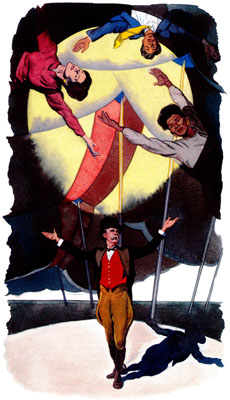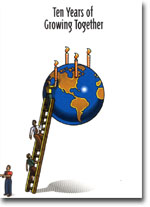
Making It Work
Ten Years Of Growing Together - 1995 - AT&T Capital Corporation
The ongoing success of funding fever confirmed the need to complete the redesign of the high-volume side of the business based on the principles set by Paul Gustavson and Jim Tenner. The design team, in place before the crisis, consisted almost entirely of operating system members, the ones who did the actual work of approving credit, funding deals and servicing accounts. Once funding fever subsided, they moved ahead to finish the job. Eventually, they became known simply as Team E.
Marinza Haznedari, a 21-year-old, fresh out of college, had begun working for the vendor as a temporary employee. She was selected as part of Team E, and was overwhelmed by the whole thing.
"I wanted to be part of it," Marinza says, "but I was still nervous. I was very young, and had never had any real responsibility before in my life. On the other hand, my work at that point was incredibly monotonous and, frankly, I saw it as an opportunity to help change that. I also think a lot of US realized that ue couldn't keep doing things the way we were and be a quality group.
Team E, she remembers, started work in the spring of 1986 by "locking ourselves in a conference room for many, many days. We walked through the whole process, from the fax room to collections. There were flow charts all over the place. We'd tape them together and stick them on the walls wherever we could find room."
The notion that they were a self-directed team was reinforced constantly Paul Gustavson, who worked with the team throughout the entire process, sometimes as coach, sometimes as a thoughtful observer who knew how and when to ask the right questions.
"We were looking at what Paul called 'variances,' places where problems in the process flow could - or would -develop," recalls Marinza. "When we'd find one, Paul would stand there and say,"Well, this is up to you guys. What do you think should happen here?' So we'd work it out. I kept thinking that the other people on the team knew more about the operation than I did. But by the end, I knew as much as anybody else. Then I was the one who was out there serving as an example for everybody else."
Ed Mitchell was also part of Team E and as new to the operation as Marinza. "I was fortunate to get picked for the design team," he says. "I'd just started in January. AT&T took over in March, so I just rolled with the punches. I had no concept at all about what would happen, but I knew that I wanted to stick around and find out."
The concept of being self-directed, of shaping the new system, was new to Ed, too. "This wasn't like regular corporate America," he recalls. "Out there, most of the time it's a dictatorship. Somebody tells you what to do and you do it. Nobody explains why. So there we were, with people coming up and asking us what did we think about this, what did we think about that. It was pretty foreign to everybody back then."
Although a great deal of time was spent on workflow analysis, some of it delved into behavioral areas, something that Ed good-naturedly calls "the touchy-feely stuff." "It was behavioral training, things like, How are we going to behave in this new group? How are we going to relate to each other? We worked a lot on people skills. Sometimes I think we worked more on that than we did on the process."
This article was featured in Ten Years of Growing Together. The philosophical umbrella for the new system was Paul Gustavson's, but the details really belonged to Team E. The new system would be organized around the customers, and have a distinct lack of hierarchy, with the power to make decisions driven as far down the organization as possible.
After months of analysis and training, and a new system plan in place, the high-volume business moved to a new location in the Washington Office Center in Morristown, N.J.
The physical layout of the new offices followed the system philosophy and Team E's analysis of the way people actually worked together. The placement of seats and fax machines was carefully planned to make the workflow easier - and quieter. In the old facility, high walls had inhibited communication and slowed things down, so the new facility was designed with low walls that let everyone see and speak easily with each other.
The members of Team E were the first ones there. "It was an October weekend when we moved," recalls Marinza, "and we were the only ones around for the first week. The team had four fax machines, and they were constantly churning out incoming credit applications - about 80 a day. We were the first group to use the MOST sales tracking system, but it wasn't available that first week. So we had to process all the credit requests manually; type them up, and try to get them into folders so that we could input them later once the system was up and running."
The redesigned high-volume system quickly became something of a must-see for outside companies looking for new ways to improve their own system design and performance standards. AT&T used the system as well, showing off the innovative technology that was used bv the new operation.
Occasionally:, members of Team E: reflect on the company's progress. "Sometimes, when I listen to the people who work here now, and I hear them questioning how we get things done, I wish I could take them back to the beginning to understand and appreciate just how far we've come in ~o years," says Marinza. "We've come a long way."
Ed agrees: "There were some good times back then, some rocky ones, too. We were all part of the evolution of how we got here today. The history is important because it's really about accepting re-evaluation and change. That's what it's all about. It is because we re-evaluate ourselves constantly that we are successful."


